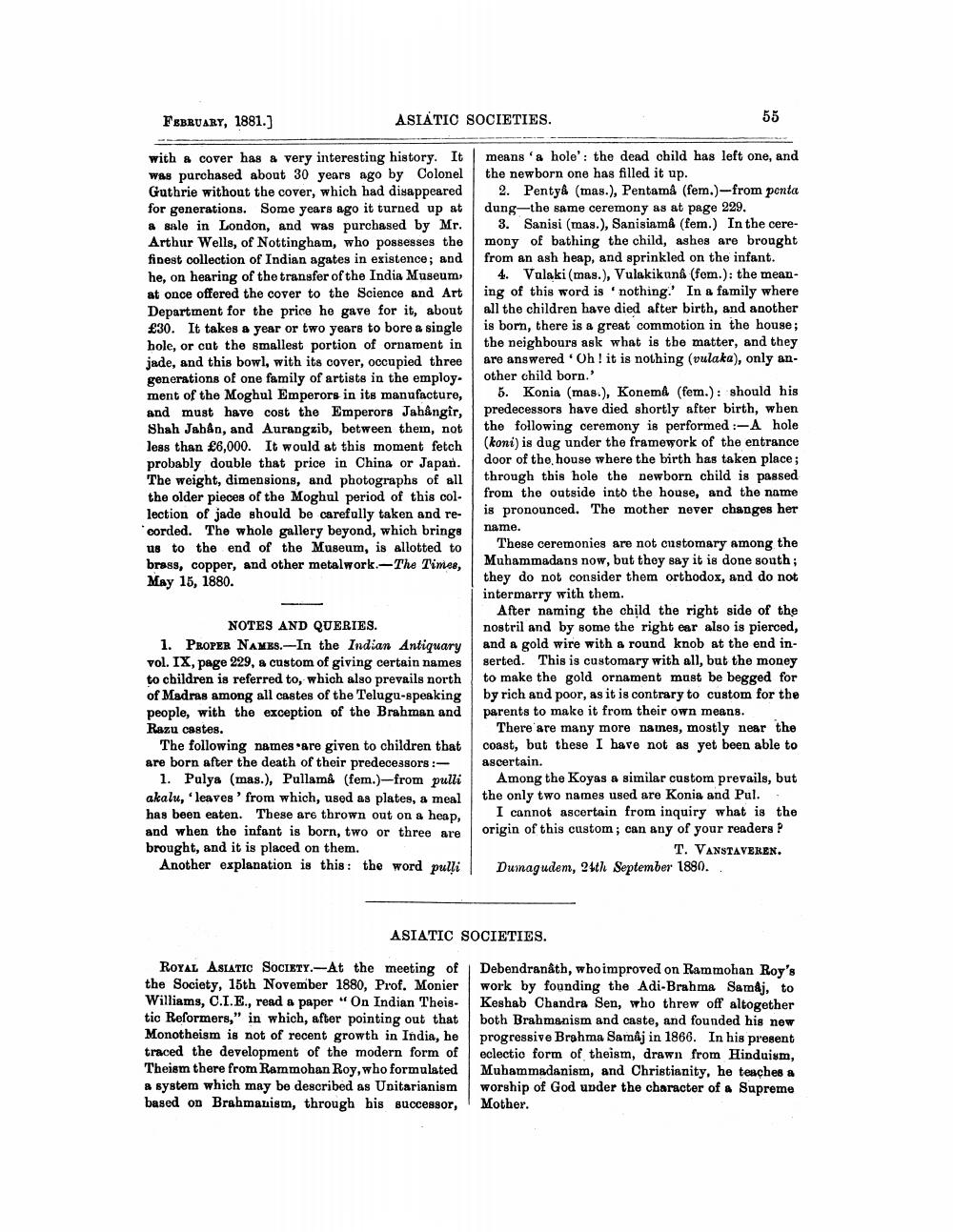________________
FEBRUARY, 1881.)
ASIATIC SOCIETIES.
55
with a cover has a very interesting history. It was purchased about 30 years ago by Colonel Guthrie without the cover, which had disappeared for generations. Some years ago it turned up at a sale in London, and was purchased by Mr. Arthur Wells, of Nottingham, who possesses the finest collection of Indian agates in existence; and he, on hearing of the transfer of the India Museum, at once offered the cover to the Science and Art Department for the price he gave for it, about £30. It takes a year or two years to bore a single bole, or cut the smallest portion of ornament in jade, and this bowl, with its cover, occupied three generations of one family of artists in the employment of the Moghul Emperors in its manufacture, and must have cost the Emperors Jahangir, Shah Jabân, and Aurangzib, between them, not less than £6,000. It would at this moment fetch probably double that price in China or Japan. The weight, dimensions, and photographs of all the older pieces of the Moghul period of this col. lection of jade should be carefully taken and recorded. The whole gallery beyond, which bringe us to the end of the Museum, is allotted to brass, copper, and other metalwork.-The Times, May 15, 1880.
means'a hole': the dead child has left one, and the newborn one has filled it up.
2. Pentyd (mas.), Pentama (fem.) - from ponta dung-the same ceremony as at page 229.
3. Sanisi (mas.), SanisiamA (fem.) In the ceremony of bathing the child, ashes are brought from an ash heap, and sprinkled on the infant.
4. Valaki (mas.), Vulakikuna (fem.): the meaning of this word is 'nothing.' In a family where all the children have died after birth, and another is born, there is a great commotion in the house; the neighbours ask what is the matter, and they are answered 'Oh! it is nothing (vulaka), only another child born.'
3. Konia (mas.), Konema (fem.): should his predecessors have died shortly after birth, when the following ceremony is performed :-A hole (koni) is dug under the framework of the entrance door of the house where the birth has taken place; through this hole the newborn child is passed from the outside into the house, and the name is pronounced. The mother never changes her name.
These ceremonies are not customary among the Muhammadans now, but they say it is done south; they do not consider them orthodox, and do not intermarry with them.
After naming the child the right side of the nostril and by some the right ear also is pierced, and a gold wire with a round knob at the end inserted. This is customary with all, but the money to make the gold ornament must be begged for by rich and poor, as it is contrary to custom for the parents to make it from their own means.
There are many more names, mostly near the coast, but these I have not as yet been able to ascertain.
Among the Koyas a similar custom prevails, but the only two names used are Konia and Pul..
I cannot ascertain from inquiry what is the origin of this custom; can any of your readers P
T. VANSTAVEKEN. Dumaguden, 24th September 1880..
NOTES AND QUERIES. 1. PROPER NAMES.-In the Indian Antiquary vol. IX, page 229, a custom of giving certain names to children is referred to, which also prevails north of Madras among all castes of the Telugu-speaking people, with the exception of the Brahman and Razu castes.
The following names are given to children that are born after the death of their predecessors :
1. Palya (mas.), Pullam (fem.)-from pulli akalu, leaves' from which, used as plates, a meal has been eaten. These are thrown out on a heap, and when the infant is born, two or three are brought, and it is placed on them.
Another explanation is this: the word pulli
ASIATIC SOCIETIES.
ROYAL ASIATIC SOCIETY.-At the meeting of the Society, 15th November 1880, Prof. Monier Williams, C.I.E., read a paper "On Indian Theis. tic Reformers," in which, after pointing out that Monotheism is not of recent growth in India, he traced the development of the modern form of Theism there from Rammohan Roy,who formulated a system which may be described as Unitarianism based on Brahmanism, through his successor,
Debendranath, who improved on Rammohan Roy's work by founding the Adi-Brahma Samaj, to Keshab Chandra Sen, who threw off altogether both Brahmanism and caste, and founded his new progressive Brahma Samaj in 1866. In his present eclectio form of theism, drawn from Hinduism, Muhammadanism, and Christianity, he teaches a worship of God under the character of a Supreme Mother.




